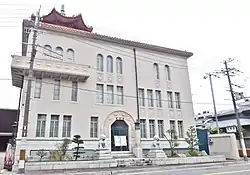Yūrinkan Museum
The Yūrinkan Museum (有鄰館) or Fujii Saiseikai Yūrinkan (藤井斉成会有鄰館) is a private museum of East Asian art in Kyōto, Japan. Established in 1926 by entrepreneur and politician Fujii Zensuke (1860–1934), it is the second oldest private museum in Japan, after the Ōkura Shūkokan.[1] The collection, particularly strong in Chinese art from the Shang to the Qing, includes one National Treasure and nine Important Cultural Properties.[2]
| Yūrinkan Museum | |
|---|---|
藤井斉成会有鄰館 | |
 | |
| General information | |
| Address | 44 Okazaki Enshōji-chō, Sakyō-ku |
| Town or city | Kyoto, Kyoto Prefecture |
| Country | Japan |
| Coordinates | 35°00′42″N 135°46′53″E |
| Opened | 1926 |
| Design and construction | |
| Architect(s) | Takeda Goichi |
| Website | |
| Official website | |
Name
The museum's name is taken from the Analects of Confucius and "expresses this feeling of good neighbourly relations".[3]
Collection
The Yūrinkan's collection of Chinese art includes bronzes, ceramics, Buddhist statues, seals, calligraphic works, textiles, and paintings, as well as nearly a hundred manuscripts from Dunhuang, including twenty-three in Uighur and others in Tibetan, Mongolian, and Sanskrit.[3][4] The museum's National Treasure consists of a fragmentary Tang manuscript of a commentary on the Spring and Autumn Annals.[5]
Buildings
The main building or "Fujii Saiseikai Yūrinkan Building No.1" of 1926 was built to a design by Takeda Goichi (武田五一) to house Fujii Kensuke's (藤井善助) collection of Chinese art. In a Chinese style both inside and out, it is topped by an octagonal pavilion with thirty-six thousand yellow glazed roof tiles dating to the time of the Qianlong Emperor. The building is a registered (as opposed to designated) Municipal Tangible Cultural Property.[1][3]
The annex or "Fujii Saiseikai Yūrinkan Building No.2" dates to the beginning of the Taishō era (1912–1926). Formerly the western-style building of the Yokoyama Mining Office (横山鉱業部), it was relocated from Kanazawa to Kyōto at the time of the enthronement of the Shōwa Emperor in 1928, to accommodate the Minister of Finance. It is registered as a National Tangible Cultural Property, alongside the 1928 storage facility.[6][7]
Access
The museum is open to the public on the first and third Sunday of each month, excepting January and August.[3]
See also
References
- 京都市指定・登録文化財-建造物(左京区) [Designated and Registered Municipal Cultural Properties of Kyoto City - buildings (Sakyō-ku)] (in Japanese). Kyoto City. Retrieved 15 September 2019.
- 公益財団法人 藤井斉成会有鄰館 [Public Interest Incorporate Foundation Fujii Saiseikai Yūrinkan] (in Japanese). Kyoto City Tourism Association. Retrieved 15 September 2019.
- 有鄰館の沿革と概要 [History and Overview of the Yurinkan Museum] (in Japanese). The Yurinkan Museum. Retrieved 15 September 2019.
- "Japanese Collections". International Dunhuang Project. Retrieved 15 September 2019.
- 春秋経伝集解巻第二残巻 [Fragments of Volume 2 of the Collected Commentaries on the Spring and Autumn Annals] (in Japanese). Agency for Cultural Affairs. Retrieved 15 September 2019.
- 藤井斉成会有鄰館第二館 [Fujii Saiseikai Yūrinkan Building No.2] (in Japanese). Agency for Cultural Affairs. Retrieved 15 September 2019.
- 藤井斉成会有鄰館収蔵庫 [Fujii Saiseikai Yūrinkan Store] (in Japanese). Agency for Cultural Affairs. Retrieved 15 September 2019.